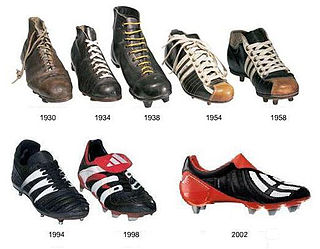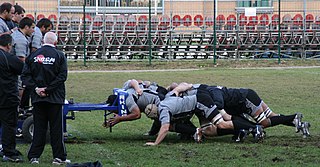 W
WFootball boots, called cleats or soccer shoes in North America, are an item of footwear worn when playing association football. Those designed for grass pitches have studs on the outsole to aid grip. From simple and humble beginnings football boots have come a long way and today find themselves subject to much research, development, sponsorship and marketing at the heart of a multi-national global industry. Modern "boots" are no longer truly boots in that they do not cover the ankle - like most other types of specialist sports footwear, their basic design and appearance has converged with that of sneakers since the 1960s.
 W
WCompression garments are pieces of clothing that fit tightly around the skin. In medical contexts, compression garments provide support for people who have to stand for long periods or have poor circulation. These come in varying degrees of compression, and higher degree compression sleeves, such as sleeves that provide compression of 20–30 mmHg or higher, typically require a doctor's prescription. Compression garments worn on the legs can help prevent deep vein thrombosis and reduce swelling, especially while traveling.
 W
WA mouthguard is a protective device for the mouth that covers the teeth and gums to prevent and reduce injury to the teeth, arches, lips and gums. "An effective mouthguard is like a ‘crash helmet’ for teeth and jaws. It also prevents the jaws coming together fully, thereby reducing the risk of jaw joint injuries and concussion." A mouthguard is most often used to prevent injury in contact sports, as a treatment for bruxism or TMD, or as part of certain dental procedures, such as tooth bleaching or sleep apnea treatment. Depending on application, it may also be called a mouth protector, mouth piece, gumshield, gumguard, nightguard, occlusal splint, bite splint, or bite plane.
 W
WA rugby ball is an elongated ellipsoidal ball used in rugby football. Its measurements and weight are specified by World Rugby and the Rugby League International Federation, the governing bodies for both codes, rugby union and rugby league respectively.
 W
WThe rugby league playing field, also referred to as a pitch or paddock, is the playing surface for the sport of rugby league football and is surfaced exclusively with grass.
 W
WA rugby shirt, also known as a rugby jersey, is worn by players of rugby union or rugby league. It usually has short sleeves, though long sleeves are common as well.
 W
WRugby shorts are a type of shorts that are worn while playing rugby. They are designed to take the strains of the game and have traditionally been made from cotton.
 W
WRugby socks are similar to the long socks that are worn in other sports such as football (soccer). They are intended to be worn pulled up just below the knee and cover the shins and calves and are designed to be hardwearing.
 W
WThe scrum cap is a form of headgear used by rugby players to protect the ears in the scrum, which can otherwise suffer injuries leading to the condition commonly known as cauliflower ears. Although originally designed for forwards they are now worn by players of all positions, even those who do not play in the scrum.
 W
WA scrum machine, or scrummaging machine, is a padded, weighty device against which a pack of rugby football forwards can practice scrummaging and rucking. The purpose of the scrum machine is to provide teams with a safe tool with which to improve the strength and skills of their players.
 W
WA shin guard or shin pad, is a piece of equipment worn on the front of an athlete's shin to protect it from injury. These are commonly used in sports including association football, baseball, ice hockey, field hockey, lacrosse, cricket, mountain bike trials, and other sports. This is due to either being required by the rules/laws of the sport or worn voluntarily by the participants for protective measures.